Burning the Midnight Oil, Part 1
Now that previews are over, it's time to start telling some card-by-card tales from Innistrad: Midnight Hunt's design. So, sit back for some monster stories.
Werewolves
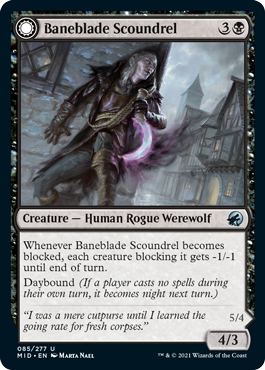

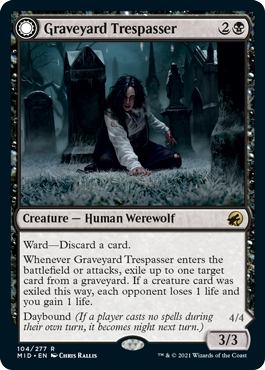
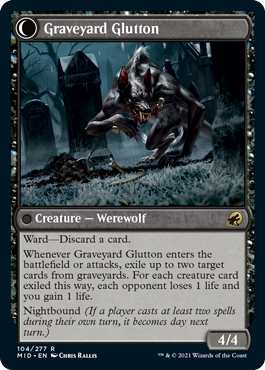
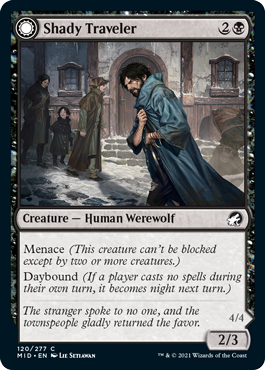
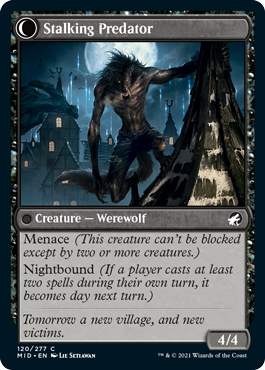
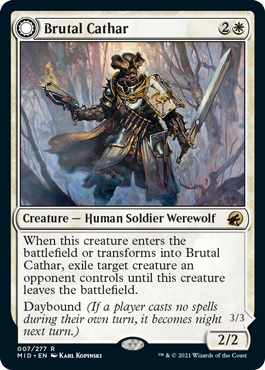
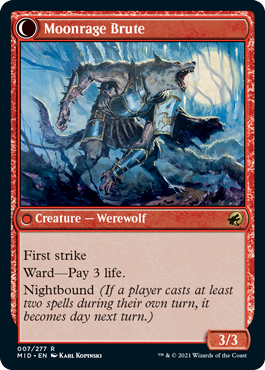

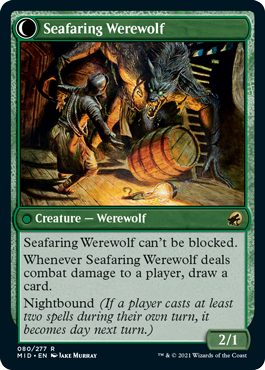
While making original Innistrad, one of our challenges was resisting the pull to make everything black. The world had a black center, and it would have been easy to just make every monster black, but Magic has five colors that need to be evenly balanced (although design did try to do a few more black cards than the other colors, but development nixed it for Limited balance reasons—that's why you're unlikely to see something like Torment or Judgment again), which means every monster couldn't be in black. After examining the ethos of Werewolves, we decided that it was about Humans reverting to their primal nature and that we could set them in red and green.
Fast-forward to Innistrad: Midnight Hunt vision design. We knew we wanted a Werewolf focus for the set, so we decided it would be cool to add them in a third color. Black was the obvious choice. It was the color the first three Werewolves had been in, all pre-Innistrad, and the one we'd resisted picking in the first place. So, we added three black Werewolves to the set, a vertical cycle (one common, one uncommon, and one rare). Shady Traveler // Stalking Predator, the common, was just made to be a French vanilla (i.e., a creature with just creature keywords and no other rules text) Werewolf with menace.
We looked at creature keywords exclusive to black (deathtouch or lifelink) but found menace just worked better. For the uncommon, Baneblade Scoundrel // Baneclaw Marauder, we did look at giving it something that black would do that neither red or green would (barring flanking from many years ago), granting -1/-1 to blockers. The backside had a trigger when blocking creatures died, and we made it life loss rather than damage to feel more black than red.
For the rare, Graveyard Trespasser // Graveyard Glutton leaned even more into black color pie space. First up, we gave it ward with discard, something only black would do. Second, we had it exile cards from the graveyard (an ability primary in black) and had it drain the opponent if that was a creature card (an effect unique to black and, interestingly, the combination of red-white). All three cards were designed to play nicely with other Werewolf cards if you wanted to try playing a black-red, black-green, or black-red-green Werewolf deck.
But we didn't stop there. Was there a way to get a Werewolf in white and blue? Neither color was a great fit for Werewolves, so we tried something a little different. What if the front side was white or blue and when it turned into a Werewolf, it became either red or green?
We chose to make white turn into the red Werewolf and blue into the green Werewolf as those were enemy colors. The trick was to make sure the backside was close enough mechanically to the front color, as that's the color of mana you needed to cast it so that it didn't break the color pie while feeling like the right color on the back.
With Moonrage Brute, it gained first strike, an ability shared by red, white, and ward—pay 3 life, an ability that white and red share, but done in the way we do it in red (white, blue, and green use a mana payment as a base, whereas black and red use a life payment). It ended up protecting the creature, so that felt like an acceptable bend in white. Seafaring Werewolf has two abilities, can't be blocked, an ability primary in blue, and "curiosity" (drawing a card when you deal combat damage), an ability shared between green and blue.
I'm happy that the Werewolf set was able to get a creature of each color that can become a Werewolf.
Cathar Commando
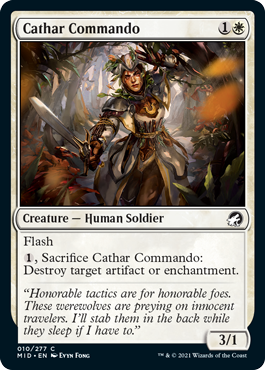
Two quick comments about this card:
- Part of rejiggering white consisted of us looking at subtle ways to help the color. I know normally when I talk about white recently, it's in the context of card drawing or ramping, but there are other facets we've been exploring. We have made the choice to upgrade flash in white from tertiary to secondary (look for a new mechanical color pie article coming later this year) as part of this master plan. We think it will help white feel a little more defensive, but in a way that helps white win the game rather than just stall.
- After making so many vanilla 3/1s for 1W over the years, it's interesting for me to see us make cards strictly better than it. Cathar Commando is better in two ways than the vanilla. I'm curious to see what the future holds for 1W 3/1's.
Curses

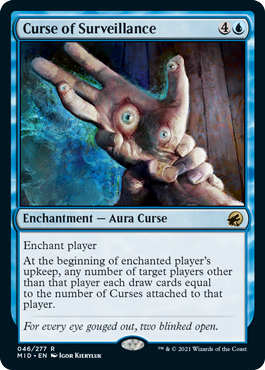
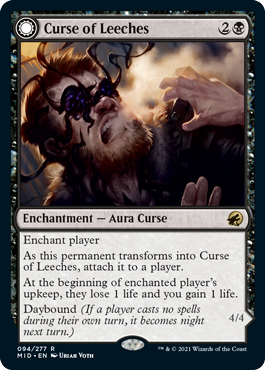
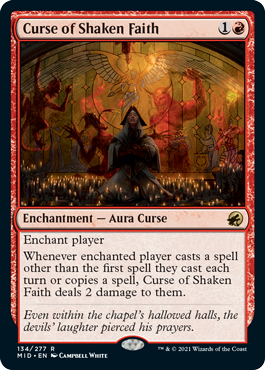
I'm writing this article before the players have seen the set, but I already know a common question I'm going to receive, so I figured I'll just get ahead of the issue. Where's the green Curse? The set has exactly four Curses, one in each color except green. What's going on? There are two different answers, so I'll give them both. For every set before I write my various articles, I take time to go through and look at all the cards. While I'm very involved in all the vision designs of the premier sets, usually two years goes by between my handing them off and them seeing print. (I do peek my head in from time to time in sets downstream in that two-year span.) That means many things change, and even when things stay the same, I've worked on a lot of sets since.
While looking through the file, I often will take notes. Which cards might be fun for my teaser? Which cards might make good card-by-card stories? Which cards do I have questions about to ask the set design lead or the creative lead? While looking through the file, I was tagging all the Curses as cards I might want to talk about. I created them many years ago, so I thought maybe I'd share the story of their evolution. Seeing one in white, one in blue, and one in black, I assumed they were a cycle. When the red one popped up, I added it to my list. But then when I got to green, there wasn't one.
This prompted a flashback to original Innistrad. We'd purposefully put Curses in every color but white to show how white was the last holdout in a world of monsters. Then we put a white Curse in Dark Ascension to show how bad it's gotten for the Humans that even white got a Curse. My plan got a little derailed though when Erik Lauer, the lead developer of original Innistrad, unaware of my plans (I'd failed to spell it out in my handoff design document) cut the green Curse from the set. "Not again," I thought to myself.
So, I wrote a text to Ian Duke, the co-set design lead on the set (Erik handed the set off to him midway through set design) and asked, "Where's the green Curse?" Ian informed me that it wasn't a cycle. For most of set design, there wasn't a Curse in black either, so no one thought of it as a cycle. The black one got added very late to fill a hole, and no one on the set design team noticed because it wasn't a pattern they were thinking about. I know it's very easy to spot things after the fact, but when you've been intimately involved with a file for a long time, it's sometimes hard to notice things as things slowly change each day. My best comparison is how people see differences in my kids that I hadn't processed because I'd seen them every day and, thus, the change happened so gradually that I wasn't aware of it.
Which leads us to the larger question—why isn't green getting Curses? In fact, there have only ever been two green Curses, and both were done in a cycle of Curses. The answer is green's mechanics don't lend themselves well to Curses. Curses are meant to be enchantments that add negative consequences to players, and that just isn't something very easy to do with green's suite of abilities.
I will acknowledge publicly that I believe making exactly four, one in each color and not in the fifth color (without a specific reason to do so—there have been actual reasons we purposefully made incomplete cycles in the past) is an error on our part. I'm a big believer in aesthetics and people's inherent need for pattern completion, so I get how this is going to annoy some people. Sorry about that. It truly wasn't on purpose. I can say, as the creator of Curses (inspired, interestingly enough, by Un- cards), I'm happy to see that we keep making more and that they're popular with certain players.
Gisa, Glorious Resurrector
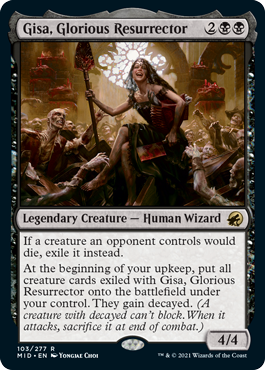
Gisa Cecani started as a character created by the Innistrad flavor text writers as a fun voice for Innistrad. She and her brother Geralf both created Zombies, but she did it through necromancy, the black way, and her brother did it through science, the blue way. Neither Gisa nor Geralf were in Innistrad block because we didn't realize the popularity their flavor text would bring them (and from a schedule standpoint, we do flavor text after most of the design is done), but finally managed to make them a shared card in Eldritch Moon. Gisa then got her first solo card in Commander (2014 Edition).
Here's the story of her card's evolution in Innistrad: Midnight Hunt. First up, here's the initial design printed in this slot:
Ludevic of Ulm 2.0 (version 1)
2UB
Legendary Creature — Human Wizard
4/4
4: Exile target instant or sorcery card from your graveyard. Return target creature card from your graveyard to the battlefield. It becomes a Zombie in addition to its other types and gains "Whenever this creature deals combat damage to an opponent, you may copy the exiled card and cast the copy without paying its mana cost."
Yes, the first card printed in this slot wasn't for Gisa at all. It was a design for Ludevic, a different Zombie maker. Ludevic did get a card, which I'll talk about next week, but it ended up being moved to another slot in the file. More on that design when we get there. So, here's the first design for this slot that was actually for Gisa:
Gisa & Geralf, Spooky Siblings (version 2)
2BB
Legendary Creature — Human Warlock
4/4
4, Exile an instant or sorcery card from your graveyard: Return target creature card from your graveyard to the battlefield. It becomes a Zombie in addition to its other types and gains "Whenever this creature deals combat damage to an opponent, you may copy the exiled card and cast the copy without paying its mana cost."
It's the same design as the original Ludevic except it was changed from a blue-black card to a mono-black card. I think the change came about partly because Ludevic was wanted for a different design and partly because the card as designed could be done as a mono-black card and didn't require any blue. (Also, technically, the card's exile cost was no longer targeted—a subtle difference, but one with rules implications.) Okay, what mono-black character raises Zombies from the graveyard? Gisa, of course. I'm not sure why this version included her brother Geralf. Geralf is clearly a blue character, and the card is mono-black. I assume this is why Geralf gets dropped from the next incarnation.
Gisa, Zombie Master (version 3)
2BB
Legendary Creature — Human Wizard
4/4
Whenever a nontoken creature an opponent controls dies, return that card to the battlefield under your control. It's a black Zombie in addition to its other colors and types and gains "This creature can't block" and "When this creature deals damage, sacrifice it."
I believe the key reason this card got changed was because they wanted to integrate the decayed keyword as it was something specific to this set, but it also allowed them to design a card that was a little more Gisa in feel. Ludevic is more creative in his Zombie making. Gisa just enjoys making a lot of Zombies. The idea that every creature of the opponent that dies becomes a Zombie for you felt cool and the decayed mechanic allowed us to be much more aggressive with the costing. The final card basically has the same general function but makes use of the exile zone to slow the card down a little. I believe it lost making a black Zombie for rules text space limitations.
Liesa, Forgotten Archangel
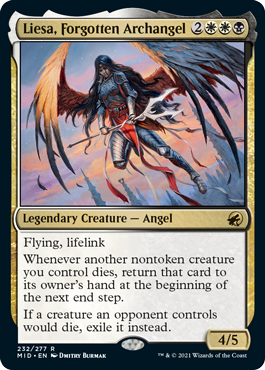
In original Innistrad, we met three sister Angels—Bruna, Gisela, and Sigarda. They were all white and each had a different second color (blue, red, and green, respectively). In the short story "A Gaze Blank and Pitiless," we learned that there was a fourth sister who was white and black. As is usually the case, once we mention the existence of a new character, players ask us to make a card for them. So, in Commander Legends, we made
But we were back on Innistrad, and it turns out Liesa wasn't dead anymore (Avacyn had originally killed her—tune in to the web fiction to find out how and why she's back), so that meant we had to make a new card for her. Although, as you will see, it took a little while for us to make a card for her. Here's the first card designed for this slot:
Nadia Markov (version 1)
WB
Legendary Creature — Vampire Noble
2/3
Whenever you sacrifice a creature, target opponent sacrifices a creature.
The first version of this card was Nadia Markov. I'm not exactly sure who she is, but obviously she's a member of the Markov clan (aka related to Sorin). It was a variant on
The Ermodun Family (version 2)
WB
Legendary Creature — Human
2/3
1, Sacrifice a creature: Put a +1/+1 counter on each creature you control.
The next version changed a bunch of things. First, instead of a member of the Markov family, it became a whole other family, this time Human cannibals instead of Vampires. My guess on this was the Markovs play a big role in Crimson Vow, so I think they wanted any Markovs there. Second, instead of being a sacrifice reward, it became a card that made use of sacrifice. Third, unlike the previous design, this design has a white element to it with the +1/+1 counter effect. Nadia could have been a mono-black design. This led to the next version:
The Ermodun Family, Cannibal Clan (version 3)
WB
Legendary Creature — Human
2/3
2, Sacrifice another nontoken creature: Create X 1/1 white Human creature tokens, where X is the sacrificed creature's power.
This next version kept the same flavor but changed the output to a different white effect, making 1/1 Humans creature tokens. This effect was a little more powerful, so they had to up its activation cost. The team wasn't happy with this design in playtest though, so they tried something very different:
Angel of Purgatory (version 4)
2WB
Creature — Angel
3/3
Flying
Whenever another nontoken creature you control dies, return that card to its owner's hand.
This version became an Angel. It protected your creatures by sending them to your hand instead of the graveyard when they die.
Liesa, Life's Burden (version 5)
4WB
Legendary Creature — Angel
5/5
Flying
Whenever another nontoken creature you control dies, return that card to its owner's hand at the beginning of the next end step.
I think this is the point where the Creative team figured out Liesa was going to be in the story and was looking for a card for her. Well, how about the white-black Angel? Once it was Liesa, that meant it had to get bigger. Her Commander Legends card had been a 5/5. The Set Design team also added a delay for getting the creature card back to avoid combo issues with sacrifice outlets.
Liesa the Hidden Angel (version 6)
2WWB
Legendary Creature — Angel
4/4
Flying, lifelink
Whenever another nontoken creature you control dies, return that card to its owner's hand at the beginning of the next end step.
The next version tweaked the card to make it closer to Liesa's last version. The mana cost was made to match, and she was given lifelink. To do that, they changed her from a 5/5 to a 4/5. The printed version is close to this one with two changes. She went from a 4/4 to a 4/5 and they added in a mirrored effect where the opponent's creatures can never come back when they die.
Done for the Midnight
That's all the time I have for stories today. I hoped you enjoyed them. As always, I'm eager to hear your feedback on this column, any of the stories I shared, or on Innistrad: Midnight Hunt itself. You can email me or contact me through any of my social media accounts (Twitter, Tumblr, Instagram, and TikTok).
Join me next week when I continue sharing Innistrad: Midnight Hunt card-by-card design stories.
Until then, may you have fun in or out of the full moon.
- Episode 866 Equipment, Part 2
- Episode 865 Strixhaven with Taylor Ingvarsson
- Episode 864 Equipment, Part 1

